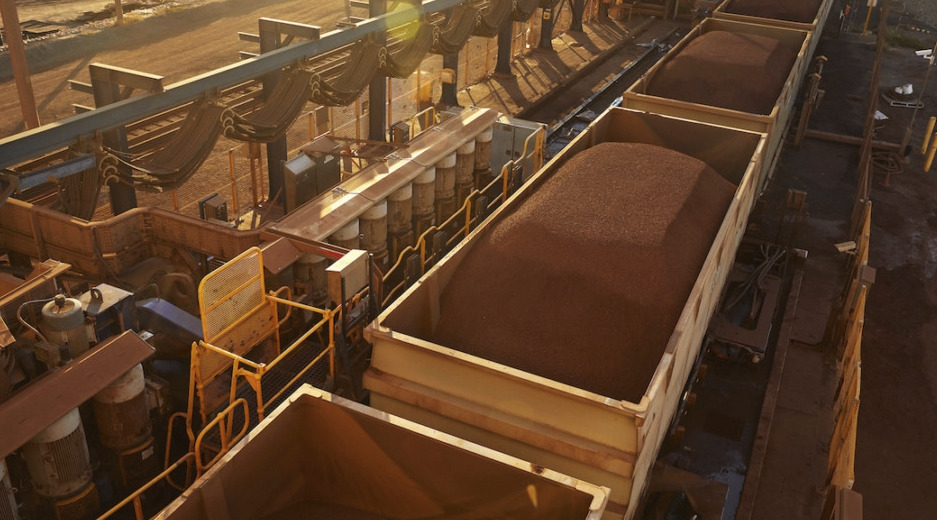Emission Control: WoodMac analysts with 6 energy predictions for 2022

It is tempting to look back, but it is usually more interesting to look forward. Pic: Getty
- Sun Metals aims to be one of the first refineries to produce “green” zinc
- World’s busiest coal port goes 100% renewable
- Fortescue purchases two battery electric locomotives
WoodMac analysts offer predictions for 2022
Though the rapid rise of the Omicron variant of the COVID-19 virus has cast a shadow over the new year, Wood Mackenzie says many of the fundamental trends driving the energy and natural resources industries remain highly resilient in 2022.
1 – Carbon prices around the world will reach new highs
WoodMac’s head of carbon Elena Belletti says carbon prices in compliance markets, including the EU’s Emissions Trading System and China’s National Emission Trading Scheme will continue to increase in 2022, driven by long-term climate policy fundamentals.
“To support their decarbonisation pledges, governments will also continue to increase the rates of existing carbon taxes, and introduce new ones.”
2 –Distributed solar installation will grow significantly in 2022
WoodMac head of solar Xiaojing Sun believes developing distributed solar capacity will be an objective for policy makers in many important markets around the world.
“China will continue its ongoing effort to increase dramatically the utilisation of distributed solar in its rural areas,” he said.
“Germany’s new coalition government has a target of installing 200 gigawatts of solar by 2030, which will rely heavily on residential solar resources and distributed solar will remain the dominant model in Japan, Australia, Belgium, and Poland.”
Policymakers and energy service providers around the world will also increasingly leverage the growing distributed solar fleet to support grid stability he said.
This means “more Australian households will add storage to their rooftop solar systems to hedge against the rising cost of interconnection and lower solar electricity export tariffs” Sun added.
3 – China’s power surge will tighten renewable energy supply chains
WoodMac vice chairman of energy Gavin Thompson says China’s economic growth at more than 8% in 2021 fired up soaring power demand: China’s electricity consumption grew by 10%, which was the fastest annual growth for any major economy in the recorded history of the industry.
“This has led to a massive surge in wind and solar investment in China, and given that the country accounts for over 50% of wind turbine manufacturing capacity and almost 70% of all solar panel output, that will exacerbate the challenges facing already tight global supply chains for renewable energy in 2022,” he said.
4 – Electric vehicles will take a double-digit share of global market for the first time ever
Ram Chandrasekaran, WoodMac’s head of transport believes that while some government support for EVs will weaken in 2022 – Europe will continue rolling back its EV “super-credits”, and China plans to tamp down EV subsidies – overall internal combustion engines have not been challenged to this degree since the days of the Ford Model T.
“Global EV sales are projected to top 8.5 million,” he said.
“Combined with the lingering effects of the chip shortage impacting conventional car sales, EVs are set to take a bigger share than ever in 2022.”
5- Oil and gas companies will move beyond wind and solar for low carbon strategies
According to WoodMac senior vice president of corporate research Tom Ellacott, oil and gas companies will invest record levels into new energy in 2022, and the strategic narrative will broaden out.
“For the European Majors, the focus of attention and capital investment has largely been on wind and solar,” he said.
“But in 2022, Carbon Capture, Utilisation and Storage, and low-carbon hydrogen, will move from growing ambition to meaningful commitment.”
6 – The market will not run short of oil in 2022
WoodMac head of macro oils Ann-Louise Hittle predicts robust growth in oil demand for 2022 as global consumption continues its recovery to pre-pandemic levels, a milestone likely to be reached in the second half of the year.
“Turning to global oil supply, we forecast an increase of over 4 million barrels per day for 2022, similar to the projected increase in demand,” she said.
“The net effect is we expect a more balanced market for 2022 and easing of concerns about potential supply shortages.”
‘Green zinc’ is coming
Korea Zinc, the parent company of Sun Metals Corporation, has partnered with Switzerland-based energy storage developer Energy Vault to help decarbonise operations at its Sun Metals zinc refinery south of Townsville, Queensland.
The partnership will see Korea Zinc inject US$50 million (A$70 million) into Energy Vault to make use of its energy storage and management software technology.
Sun Metals is aiming to become one of the first zinc refineries to produce “green” zinc in support of their broader strategy to shift to 100% renewable power by 2040 with an interim target of 80% renewable by 2030.
This announcement comes after Korea Zinc announced its acquisition of leading utility wind and solar energy developer Epuron towards the end of December, which brings more than 9 GW of wind and solar projects with it.
Sun Metals is currently the second largest consumer of electricity in Queensland, Australia with greater than 1 terawatt hours of consumption per annum.
The two companies plan to begin project deployment in mid-2022.
World’s busiest coal port goes 100% renewable
The Port of Newcastle has made its way into the new year powered by 100% renewable energy, marking a step towards its plan to decarbonise the business by 2040 and to increase the non-coal portion so that coal only makes half its revenue by 2030.
It comes as coal power generation in Australia’s national electricity market fell to its lowest level in the final three months of 2021.
Known as ‘the world’s busiest coal port’, exporting an average of 165Mt of coal a year, it has also partnered with green energy supplier, Iberdrola – the operator of the Bodangora Windfarm in Orange, New South Wales for a retail power purchase agreement.
This agreement will provide the port with large scale generation certificates linked to the windfarm.
The Port’s senior manager of ESG, Jackie Spiteri, said the renewables achievement strengthens the renewables supply chain already bolstered by the Port being a leading importer of wind turbines and its future plans for it to support a hydrogen export hub.
“By working with Iberdrola to secure our Power Purchase Agreements we have been able to source green power directly from Bodangora Wind Farm,” she said.
“As fate would allow, all of the wind turbine blades and components for Bodangora Wind Farm were imported right here through Port of Newcastle’s Multi-Purpose Cargo Facility at Mayfield 4 berth.”
During December, Spiteri said the Port completed an LED lighting upgrade to more than 400 lights on its 792-hectare site, which will result in even further energy efficiencies and stronger Port safety.
Fortescue purchases two battery electric locomotives

Fortescue Metals Group’s (ASX:FMG) chairman Andrew Forrest has quickly taken things upon himself to represent Australia as its unofficial spokesperson for the green hydrogen industry but now it is adding battery powered locomotives to its list as well.
The business said two 8-axle battery electric locos with an energy capacity of 14.5MWh will be manufactured at the Progress Rail facility in Sete Lagoas, Brazil.
The first delivery of the locos, which will transport its iron ore to port in the Pilbara, is expected next year.
FMG chief executive officer Elizabeth Gaines said: “The new locomotives will cut our emissions while also reducing our fuel costs and our overall operational expense through lower maintenance spend.
“The acquisition builds on the work being carried out by Fortescue Future Industries’ Green Team in Hazelmere to deliver locomotives operating solely on green ammonia and other green renewable fuels and technologies.”
ASX green energy stocks
| CODE | COMPANY | PRICE | 1 WEEK RETURN % | 1 MONTH RETURN % | 6 MONTH RETURN% | 1 YEAR RETURN % | MARKET CAP |
|---|---|---|---|---|---|---|---|
| AST | AusNet Services Ltd | 2.57 | 0% | 2% | 45% | 44% | $9,766,409,439.30 |
| AVL | Aust Vanadium Ltd | 0.031 | -3% | 7% | 55% | 94% | $101,723,682.29 |
| BSX | Blackstone Ltd | 0.58 | 4% | 5% | 61% | 40% | $265,262,563.35 |
| DEL | Delorean Corporation | 0.205 | -2% | 0% | 0% | 0% | $37,732,438.80 |
| ECT | Env Clean Tech Ltd. | 0.032 | -14% | -32% | 146% | 220% | $53,735,752.07 |
| FMG | Fortescue Metals Grp | 19.99 | 4% | 17% | -16% | -21% | $61,456,139,763.28 |
| GEV | Global Ene Ven Ltd | 0.115 | 5% | 5% | 62% | 44% | $62,557,753.48 |
| GNX | Genex Power Ltd | 0.195 | -3% | 0% | -11% | -10% | $208,630,508.78 |
| HXG | Hexagon Energy | 0.074 | -1% | -8% | 3% | 32% | $33,897,050.85 |
| HZR | Hazer Group Limited | 1.18 | 2% | -4% | 35% | 44% | $210,951,866.23 |
| IFT | Infratil Limited | 7.7 | 2% | -2% | 6% | 9% | $5,721,625,818.75 |
| IRD | Iron Road Ltd | 0.205 | 0% | -5% | -13% | 28% | $159,101,613.00 |
| LIO | Lion Energy Limited | 0.069 | 0% | -3% | 41% | 73% | $27,529,936.06 |
| MEZ | Meridian Energy | 4.51 | -3% | -2% | -7% | -45% | $5,824,309,583.40 |
| MPR | Mpower Group Limited | 0.039 | -3% | -13% | -47% | -30% | $8,662,677.89 |
| NEW | NEW Energy Solar | 0.815 | -1% | -1% | -4% | -11% | $262,882,148.52 |
| PGY | Pilot Energy Ltd | 0.054 | 4% | -21% | -34% | 100% | $26,584,890.15 |
| PH2 | Pure Hydrogen Corp | 0.525 | -4% | 18% | 163% | 518% | $182,877,112.26 |
| PRL | Province Resources | 0.1425 | -5% | -5% | -2% | 918% | $163,800,672.60 |
| PRM | Prominence Energy | 0.0095 | 19% | -14% | -32% | 19% | $11,561,479.37 |
| QEM | QEM Limited | 0.19 | 3% | 0% | 27% | 111% | $21,550,433.27 |
| RFX | Redflow Limited | 0.053 | 6% | 4% | -21% | 106% | $76,307,937.46 |
| SKI | Spark Infrastructure | 0 | -100% | -100% | -100% | -100% | $5,036,718,783.60 |
| VUL | Vulcan Energy | 9.91 | -6% | -1% | 20% | 226% | $1,345,029,651.56 |
| CXL | Calix Limited | 6.33 | -2% | -2% | 129% | 527% | $1,085,657,534.71 |
| KPO | Kalina Power Limited | 0.024 | 4% | -6% | -20% | -33% | $34,770,893.66 |
| RNE | Renu Energy Ltd | 0.084 | 4% | -13% | 42% | 121% | $13,847,174.30 |
| LCK | Leigh Crk Energy Ltd | 0.175 | 9% | 25% | 9% | -3% | $155,918,233.80 |
While Prominence Energy (ASX:PRM) gained 9% this fortnight on no news, Leigh Creek Energy (ASX:LCK) has surged following the grant of a Aboriginal Heritage Act authorisation.
This allows the miner to carry out development works of its in-situ gasification project within the former Leigh Creek Coalfied.
The authorisation was sought to enable the gasification of underground coal deposits using insitu gasification techniques, drilling of wells for exploration, production, monitoring and hydrogeological purposes.
Related Topics
UNLOCK INSIGHTS
Discover the untold stories of emerging ASX stocks.
Daily news and expert analysis, it's free to subscribe.
By proceeding, you confirm you understand that we handle personal information in accordance with our Privacy Policy.








